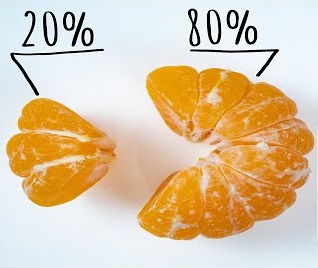
The Pareto Principle, also known as the 80/20 Principle, is a very effective concept in achieving efficiency. Instead of wasting time and resources on unimportant tasks, one can focus on the core productive activities. This principle is one of the essential concepts in modern-day business and holds the same value in forex trading.
Background
This principle was discovered in 1897 by the Italian economist and mathematician Vilfredo Pareto. This discovery strangely took place while planting peas in his garden.
Among the pea pods planted in total, he noticed that only a small fraction of his plants produced the majority of his peas. He took count and noticed that roughly 20% produced 80% of his crop. This unequal distribution happened on a consistent basis.

Then he noticed how 80% of Italy’s lands were owned by only 20% of the wealthiest people. Once he carried out surveys of similar land distribution in other countries, that’s when he confirmed his 80/20 rule.
In a nutshell, the pattern underlying the 80/20 Principle is that the distribution of results is predictably unbalanced. The 80/20 rule states that 20% of the input will create 80% of the results/output (give or take). Put differently – 20% of the resources will create 80% of the success.
In macro terms, input/resources could be anything from time, money, effort, skill, etc… that a person or organisation puts into achieving goals. Output/success could be anything related to the desired target – sales, profit, customer acquisition, customer satisfaction, etc…
Here are just a few of the everyday examples of the Pareto Principle being put into place in the real world:-
- A study of world GDP revealed that 20% of the countries held 80% of the world’s capital.
- In academics, 20% of all students have grades that are 80% or higher.
- In the game of poker, 20% of the players tend to walk away with at least 80% of the stakes.
- In sports, only 20% of the exercises impacted 80% of an athlete’s overall performance.
- In healthcare, 20% of the hazards are responsible for 80% of all injuries.
- In businesses, 20% of customers are often responsible for 80% of the revenue.
- In the work environment, 20% of workers are responsible for 80% of a company’s production and 20% of employee effort leads to 80% of overall productivity.
- More importantly, keeping the principle in mind, 20% of your trades may lead to 80% of your profits (or losses).
The Pareto Principle in Trading
The 80/20 rule not only holds true for the analysis of our Profit & Loss account, but a wider scope of topics. There are many ways forex traders can apply the analysis from the 80/20 Principle.
Things to note:-
- 80% of the time the market is ranging, 20% of the time it is trending.
- 80% of the time the market is consolidating, 20% of the time it is in an impulse (substantial momentum to the up or downside).
- 80% of the time the market is in the middle of a move, 20% of the time the market is forming a top or bottom.
- 80% of the market moves are noise, 20% of the market moves are an actual signal.
The figures above are actually approximate but the overall concept is important to keep in mind. One may not find a clear 80/20 distribution but something similar to a 75/25 or 90/10. When reflecting on the 80/20 Rule, it is imperative not to get stuck on the exact numbers but to reflect on the importance of uneven distribution. So, from an overall perspective, 80% of one’s success may come from only 20% of their actions. It is therefore important to establish what are the main areas in which to apply one’s focus, in order to reap the larger rewards.

With regards to your forex level of success, possibly:-
- 80% of your trading profits might be generated by only 20% of your trades.
- 80% of your portfolio’s profits might be coming from only 20% of your positions.
- 80% of your losing trades might be caused by 20% of your mistakes.
- 80% of your losses may come from 20% of the timeframes.
- 80% of your wins may be generated by 20% of the same entry type.
- 80% of your profits come from 20% of the strategies you are currently using.
- 80% of your wins may be generated using 20% of your set indicators.
- 80% of your wins may be generated by 20% of trades carried out in a specific time of the day.
- 80% of your profits come from 20% of the currency pairs you are currently trading.
How can knowing these personal statistics help one in his/her own trading journey?
As you develop the 80/20 rules, you can consider looking at all of your trades and identify the most profitable ones.
For the more experienced trader, for example, by getting into specifics, one may notice that the majority of his profits are generated by winning trades traded during London hours for the first three hours of the day, scalping the EUR/USD and USD/JPY markets on the 1-hour timeframe using the MACD crossover strategy when markets are trending upwards.
By having such information at hand, one may focus on the main actions that are producing the major favourable results.
In conclusion, the Pareto Principle is a trader’s golden rule allowing one to focus on the most important tasks in order to achieve the best possible outcome. In reality, the percentage of successful traders is probably less than 20% of the entire trading field. However, it is encouraging to note that there are indeed traders who have amassed large fortunes in forex trading and not all of them started with a huge amount of capital or extraordinary skills. The point is that, like in most areas of life, the minority seize the majority of forex traders and you want to belong to that successful minority. How to do that? Don’t think like the remaining 80%.
